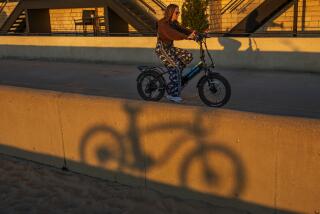Remember Walking? Neither Do Most Kids
- Share via
A woman I know once spent 10 minutes looking for a parking place in front of the YMCA even though there was ample parking a mere three blocks away.
I, er, that is, she, can’t be the only one trapped in such irony--most gyms have pretty big parking lots that are often full. And yet there is something fraudulent about driving to a place to get on a treadmill, something that awakens the inner grandma in us all--”You pay money to exercise? You can walk for free.”
According to conventional wisdom, nobody walks in L.A. But according to the U.S. Department of Transportation, a more reliable source, practically nobody walks anywhere: Walking has decreased nationwide from 9.3% of all trips in 1977 to 5.4% in 1995. This despite the fact that one-quarter of all trips (defined as any kind of travel at all) are one mile or less. Meanwhile, Americans spend between $35 billion and $50 billion annually on diet products and programs.
In a recent report by the Surface Transportation Policy Project, a nonprofit safety group, there are two little graphs dealing with obesity and trips on foot that speak volumes about this seeming disconnect. One is for adults and one is for children, and both show what we all know in our hearts--the less we walk, the fatter we get.
Which I guess would be OK for grown-ups--people have a right to be fat--but it’s difficult to be cavalier about the children. Between 1988 and 1994, the percentage of overweight kids grew from 5.5 to 13.6. Meanwhile the percentage of trips children made on foot declined from 16 to 9. (Michelle Garland, an analyst for the safety group, says there’s been a decline in children’s bike trips as well.)
Thirty years ago, according to researchers at the U.S. Centers for Disease Control, more than two-thirds of American children walked to school. Today, that percentage is less than 10.
For those of us who remember those daily treks, and the accompanying snowdrifts, this might seem to be more proof of the General Decline of Youth Today. But according to the Surface Transportation Policy Project, it’s more a communal than a personal problem. Many modern neighborhoods are simply not designed to encourage, or even allow, walking to schools or store.
In Los Angeles, walking in some areas--across very busy thoroughfares or in neighborhoods where there are no sidewalks--can be hazardous. According to a related study by the policy project, California ranks second after New York in percentage of traffic deaths that involve pedestrians.
Fear for their children’s safety--from traffic and other hazards--has led many parents to shuttle kids to and from school, increasing rush-hour traffic by as much as 25%. More traffic increases the risks, which increases the fear, which increases the traffic and so on.
The Surface Transportation Policy Project calls for a variety of solutions, including a commitment to making our cities and suburbs more foot-friendly (the study and proposed solutions can be viewed at https://www.transact.org), which would, of course, be a very good thing.
But while we’re waiting for miracles to occur at City Hall, the grown-ups among us might want to think about examples and the benefits of setting them. Driving everywhere is often as much habit as necessity. So why not walk once in a while to the post office, or the park, or the store? Oh, sure, it might take an extra hour, and entail pushing 60 pounds of stroller-bound offspring or schlepping a few bags up a hill. But then, any trip to the gym takes at least an hour, and this way you don’t even have to think about parking.



